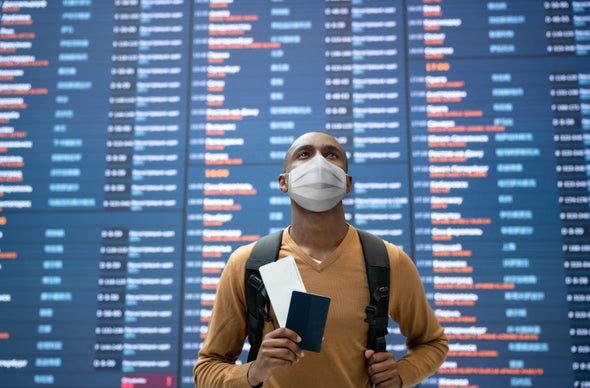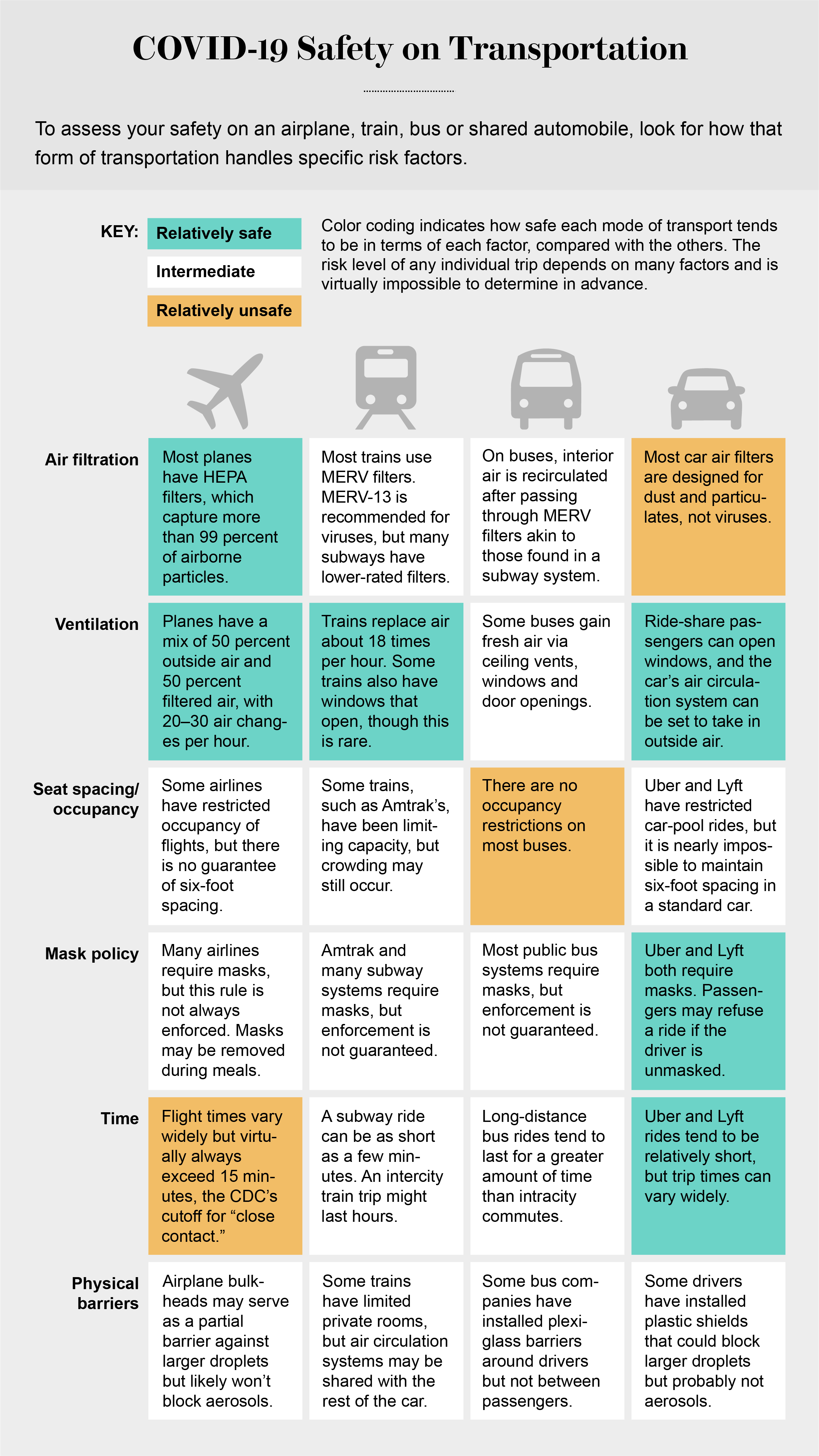
With COVID-19 reaching the most dangerous levels the U.S. has seen since the pandemic began, the country faces a problematic holiday season. Despite the risk, many people are likely to travel using various forms of transportation that will inevitably put them in relatively close contact with others. Many transit companies have established frequent cleaning routines, but evidence suggests that airborne transmission of the novel coronavirus poses a greater danger than surfaces. The virus is thought to be spread primarily by small droplets, called aerosols, that hang in the air and larger droplets that fall to the ground within six feet or so. Although no mode of public transportation is completely safe, there are some concrete ways to reduce risk, whether on an airplane, train or bus—or even in a shared car.

Airplanes
At a casual glance, air travel might seem like the perfect recipe for COVID transmission: it packs dozens of people into a confined space, often for hours at a time. But many planes have excellent high-efficiency particulate air (HEPA) filters that capture more than 99 percent of particles in the air, including microbes as SARS-CoV-2, the coronavirus that causes COVID. When their recirculation systems are operating, most commercial passenger jets bring in outside air in a top-to-bottom direction about 20 to 30 times per hours. This results in a 50–50 mix of outside and recirculated air and reduces the potential for airborne spread of a respiratory virus. Many airlines now require passengers to wear a mask during flights except for mealtimes, and some are blocking off middle seats to allow more distancing between people. Companies have also implemented rigorous cleaning procedures between flights. So how does this translate into overall risk?
“An airplane cabin is probably one of the most secure conditions you can be in,” says Sebastian Hoehl of the Institute for Medical Virology at Goethe University Frankfurt in Germany, who has co-authored two papers on COVID-19 transmission on specific flights, which were published in JAMA Network Open and the New England Journal of Medicine, respectfully. Still, a handful of case studies have found that limited transmission can take place onboard. One such investigation of a 10-hour journey from London to Hanoi starting on March 1 found that 15 people were likely infected with COVID-19 in-flight—and that 12 of them had sat within a couple of rows of a single symptomatic passenger in business class. (The results were published this month in the U.S. Centers for Disease Control and Prevention’s journal Emerging Infectious Diseases.) Most of these flights occurred early on in the pandemic, however, and in the case of the March 1 flight, masks were likely not worn, the researchers wrote. Meanwhile a recent Department of Defense study modeled the risk of in-flight infection using mannequins exhaling simulated virus particles and found that a person would have to be exposed to an infectious passenger for at least 54 hours to get an infectious dose. This finding assumes the infected passenger is wearing a surgical mask, however, and it does not account for the dangers involved in removing the mask for meals or talking or in moving about on the plane.
With flying, COVID risk really comes down to how closely one sits to other people and for how long, whether or not everyone is wearing a mask, and how infectious any passengers are at the time. If you happen to be seated close to a person who is actively “shedding” the virus, especially if it is a long flight or that person is not wearing a mask, there is a higher chance that you will get the disease. But if you are seated relatively far from others, and everyone is wearing a mask, your risk is probably fairly low. Being in a crowded airport or taking a taxi to get there could be a bigger concern, though.
Subways and Trains
This past spring the novel coronavirus tore through New York City, reaching a peak of thousands of new cases per day in April. Initially some researchers blamed the metropolis’s bustling subway—which carried 5.5 million commuters on a typical pre-COVID weekday—for making it the epicenter of the pandemic in the U.S. But later reviews of the evidence suggest mass transit systems have not been major drivers of viral spread. In August the New York Times asked several international transportation agencies whether any superspreading events had been linked to mass transit, and they said none had. A September report by the American Public Transportation Association (APTA) examined the coronavirus’s spread in cities around the globe that had robust public transit systems. It found no correlation between mass transit use and transmission of the virus. Many of the cities in question required commuters to wear masks.
The APTA report suggested that commuters should reduce risk by wearing a mask and staying six feet apart and that train cars should be well ventilated. Most major cities’ subways and trains constantly recirculate a mixture of fresh air and older air, both of which are pulled through a filter rated on the MERV (minimum efficiency reporting value) scale. MERV-13 filters are less efficient than HEPA filters, but the U.S. Environmental Protection Agency recommends them for reducing the number of airborne viral particles. A number of subway and train systems use lower-rated MERV filters that are still capable of at least reducing the volume of coronavirus in the air. The APTA report notes that on most systems’ subway cars and buses, new air replaces stale air almost 18 times an hour. Passenger train operator Amtrak claims to cycle air through cabins 44 times an hour. But even with fresh air available, an infected passenger can still transmit the coronavirus to someone who is sitting in close proximity—so riders should attempt to space themselves out and avoid densely packed cars whenever possible. Mask wearing reduces risk and is now mandatory on many forms of transit in the U.S., including New York City’s subway and bus systems, as well as Amtrak trains throughout the country. Finally, experts suggest that limiting the length of a ride can also be helpful: 15 minutes on a subway is safer than a multihour train trip.
Buses
Many buses have HVAC (heating, ventilating and air-conditioning) systems similar to those on subways and trains, with one additional factor: buses are more likely to have windows that open. Windows, as well as open ceiling vents, allow fresh air to enter the vehicle. In addition, in a city system (as opposed to a long-distance ride), buses make frequent stops. Doing so allows outside air to flood in each time the doors open. In a case study of a bus in China, a passenger with the novel coronavirus was able to infect many other riders, including those seated up to seven rows away. There seemed to be less risk of transmission, however, for people who were seated near windows and doors that could open.
In addition to snagging window seats, bus riders should look for the same safety features they would on a subway: a mask requirement, good ventilation and adequate spacing between passengers. Limiting rides to short trips may also be helpful. Some bus companies have installed clear partitions between drivers and passengers. Doing so might limit the spread of virus-carrying droplets from coughing, sneezing, breathing or speaking but is unlikely to prevent viral transmission via smaller airborne particles.
Taxis, Ubers and Lyfts
Before the pandemic, many people would not think twice about ordering a ride-share car or hailing a taxi. But now the idea of being in such an enclosed space with a stranger can seem like a life-and-death proposition. It is nearly impossible for drivers and passengers to remain six feet apart in a car, so transmission is definitely possible. An NEJM study in March reported on a Thai taxi driver who fell ill and tested positive for the coronavirus after driving some tourists who had been coughing but wearing a mask. Reliable data on the frequency of COVID transmission in cars is lacking, however.
Keeping the windows open and making sure the air system is set to take in outside air instead of recycling it should reduce the risk. Wearing a mask also probably helps, and ride-share companies Uber and Lyft both require drivers and passengers to do so. These companies have also stopped offering car pools (except in Uber’s case for people who work together), so passengers are only exposed to the driver and anyone in their own party. Some drivers have even installed a plastic shield between the front and back seats. But as is the case with buses, these barriers would likely only protect against larger droplets, not aerosols. Shorter rides—especially those under roughly 15 minutes—pose a lower risk than long ones. And keeping conversation to a minimum could also reduce the danger because talking is known to release aerosols that can spread the virus. If the rate of community transmission in your region is low, chances are that taking the occasional taxi or ride-share car is not a huge risk—provided you wear a mask and keep the windows open as much as possible.




Comments
Post a Comment